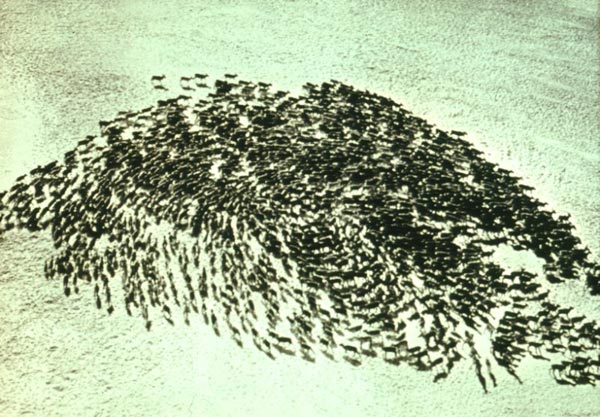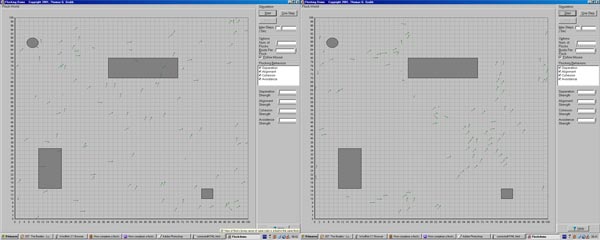Bournemouth University
19 May 2005
Abstract
Flocking
Systems have been used since their introduction in 1987 by Craig
W. Reynolds. Flocking systems were used in several
computer graphics industries and not only for research and
simulation purposes. The entertainment and film industry have
made an intensive use of flocking systems in films (eg: flock of bats
in Batman Returns, 1992) and commercials. It helps to rapidly create
the complex animations of numerous actors: flocking of birds,
schools of fishes, Herds, crowds, traffics and so forth.
Basically,
as described by C.W.Reynolds, a flocking system is an elaborated
particle system where each particle is an actor. Each actor has basic
rules that control its behaviour within the aggregate motion of
flocking actors.
The three basic rules implemented for each actor
or Behaviour Routine
are: Cohesion
and Alignment
and Separation.
With these two routines, one can implement a basic flocking system
from a particle system. One can hence simulate natural motion of
flock or any kind of synchronized motion such as flocking of birds or
schools of fishes. That is of course only two examples of use that
can be applied to other kind of actors.
Indeed, depending on the
purpose, the complexity of a flocking system can reach such a level
where is can become difficult to distinguish it from a Life
Simulation System.
A flocking system can be set up in many
different ways but generally setting up some very basic rules is
enough to bring life to actors in a flock, schools, and even a crowd.

Introduction
Today,
the use of flocking systems is a common and well understood technique
in the visual effect industry. Most popular 3d packages support the
use of particles systems. Depending on which package you use, you can
create more or less basic flocking system using already implemented
tools such as in Side
Effects Software Houdini®, where flocking
behaviours are already implemented and can be use directly without
any need of scripting. Some packages require knowledge of scripting
(usually the embedded scripting language that come with the software)
to be able to create a simple flocking system. It is the case with
Alias®
Maya® (version 6.5 at the time of writing) you
need to use the MEL (Maya Embedded Language).
As these two
packages are commonly used in the visual effects industry, most of
the flocking systems you see in commercial or films have probably
been generated from one of both.
Recently, some package go further
and implement more complex behaviour using fuzzy
logic and decision making for your flocking
system using artificial
intelligence. It is the case of Massive™
from Massive
Software®.
Artificial Life software fulfils
the need of more complex behaviours such as crowd simulation. Indeed,
flocking systems can successfully be used for synchronized motion of
actor
such as birds, fishes, ants and so forth using the two behaviours
described above where actors have very little decisions. Such
flocking systems aren’t sufficient to simulate realistic motion
of aggregated actor in the case of a crowd or any kind of simulation
where actors have to have more than three basic behaviours.
In one
hand, basic flocking systems aren't sufficient to create complexity
within an aggregation of actors but can be very quickly setup using
common 3D package in use in the visual effect industry. In the other
hand software such as Massive™
are very good to create very complex behaviours and hence, they are
very suitable for crowd simulation. But in many cases an elaborated
flocking system can fulfil the need of complexity within a flocking
system.
Creating convincing motion of a crowd can be solved using
a flocking system. How complex a flocking system has to be to look
convincing? Is the subject of this research webpage.
Basic flocking system
Flocking systems may seem complex when we watch them but they are
actually very simple. According to Craig W.Reynold
in the case of a flocking of birds "a flock is simply the result
of the interaction of behaviour of individual birds".
Interaction is the key of simulating any sort of flocks, schools,
crowd and so forth. Actors can interact between themselves or with
the environment (avoiding other actors and obstacles). Some very
complex flocking systems go further where the environment itself can
react to the flocking actors such as behavioural L-Systems.
The underlying of most flocking system and the model described by Craig W. Reynold is a particle system. A simple example of a flocking system is made of a leader and a follower, both are particles. The leader needs only one behaviour: the Avoidance capability. The follower needs at least two: the target to follow (derived from the Cohesion behaviour) and the Separation.
This is the first step to create a Flocking System. Is it enough to create a realistic flock of birds, a school of fishes? Not really. One more routine is needed to simulate that: Alignment
This one more routine constraint the followers to point a specific direction. In the case of the Leader-Follower model, the follower point toward the leader as they are following it.
Once these three behaviours have been implemented, they can already be used to create herds but not a realistic flock of birds yet. To simulate a flock of birds or of fish and any flying group of actor one more attribute is needed: the Banking.
To recapitulate, with one or more Leader and few or numerous followers
and with few attributes: target follow, collision avoidance,
alignment and banking in the case of flying actors, one can create
very realistic motion of Herds, Flocks and Schools.
It can be
enough but we are still far from the complexity of what an A.I
system can create. But with a simple approach and an efficient use of
flocking system capabilities, more complex result can be
achieved. And hence a flocking system can be used to simulate systems
as complex as crowd.
Approach to a more complex flocking system
Flocking Systems not A.I Systems
In a basic flocking systemthe few routines
are in fact the foundation of a useful flocking system. With such
flocking systems, an animator gets rapidly limited by the lack of
control that (s)he has on it.
In fact, these rules are global
in a way that they only "sculpt" the general motion of the
flock. The routines introduced above can be seen as global
routines. The limitations are the fact that every actor in the
simulation is the same and have the same behaviours. To get further
realism, we need to get further into "trait".
"Trait" means
that every actor in the flocking system is different and hence
behaving differently within the group. It might not be useful for a
school of fish, but it certainly improves the realism of Herd and
Crowd simulations. Indeed, that is what defines the nature. Every
member of any given species is different. Human beings are the
extreme example of traits.
We can differentiate two level of
trait within a group: the conduct (individual behaviour) and the
appearance (colour, size ...).
It seems tedious
to create these traits with a flocking system. One approach to solve
this problem is the use of Artificial Life system.
From a visual
effects point of view, using such a system is expensive and complex.
For a visual effects shot the most important thing is that the
simulation look as realistic as possible for a very short amount of
time. Also, A.I system doesn't give the maximum of control to
the animator and hence not being subject to any unexpected
behaviour.
Finally, A.I systems attempt to simulate senses by
creating intelligent actors that are really able to make
decisions. Flocking Systems attempt to simulate intelligence but only
visually (actors has to look as they had a brain). When a flocking
system simulation is running, it is has to look like the actors are
intelligent. But, how to increase the realism by making actors
behaving as they where taking decisions on there own?
Per-particles attributes and probability
Instead of considering each actor to be able to make decisions and then behave
according the situation we can take another approach. In A.I
Systems, even if it can take decision the actor has to choose between
routines
to face a situation. In some very advanced A.I systems the actor
can even evolve trough time but we don't consider these particular
systems. What we want to recreate with a flocking system is something
that looks like a decision happening within the flock, herd or
crowd.
We can look at decision making from another angle. We can
consider that decision making by actors within a group implying an
alteration of their behaviour as a probability of an event to occur.
The probability of an alteration of an actor's behaviour to occur is
what we want to achieve using a flocking system and neither a
decision making nor fuzzy
logic.
In an aggregate of actors, very basic behaviours can be setup for every actor by assigning a set attributes to every particle or per-particle attribute (as flocking systems I am stating here are based on a particle system). These attribute can be of any kind: speed, mass, size, sex, libido etc.
By using probabilities and mathematical functions we can than randomly or specifically distribute variations of the attributes to each particle. For example:
- 30% of the actors a female (leaders)
- 2% of immobile actors
- Random distribution of the size,libido using random function, IF statement, loops, link to other attributes.
- link to particles attributes (AGE,LIFE, ID ...)
- ...and so forth
From here, with very few attributes we have created variations for each actor. The probability of getting two actors to have the exact same characteristics decreases rapidly as the number of attributes increase.
And by linking attributes accordingly we can set up behaviours of our actors, e.g.:
- The speed diminishing as the size or the mass increase
- As the libido attributes variable increase the radius of the field of separation diminish.
- ...and so forth
Finally, using these simple parameters and applying variation on them, the flocking system would look very complex and very controllable though. The possibilities to extend such flocking systems are endless and the flocking system keeps being simple and flexible.
Conclusion
Theoretically
one can create very complex looking flocking system using very
few attributes. By linking attributes together, creating new
attribute very easily, and creating variation using simple
probabilities and mathematical expression.
Flocking systems can
fulfill 99.9 % of the need to create complex motion of actors by
faking decision making and fuzzy
logic what A.I systems are made for. It
doesn't really make sense to use A.I for short simulations as
used in films and commercials. A.I is more suitable for games,
research on robotics, crowd management, driving
simulator.
Another area to look at for flocking systems is the
ability to manage hundreds of thousands or millions of actors with as
less computing power need as possible. This is one reason of the
success of >Massive™
the A.I system from >Massive
Software®.

References
- Craig. W. Reynolds, Flocks,Herds and Schools: A Distributed behavioral model,Computer Graphics, Volume 21 #4, July 87, (acm SIGGRAPH '87 Proceedings), pp 25-34.
- H.Noser, D. Thalmann,The Animation of Autonomous actors based on Production rules,IEEE Computer Society Press, June 96, (Computer Animation '96).
- Xiaoyuan Tu, Artificial Animals for computer Animation,Springer,1999.
- D.M.Bourg, G.Seeman, AI for Game Developers,O'Reilly, July 2004.
- C.Loscos, D.Marchal,A.Meyer,Intuitive Crowd Behaviour in Dense Urban Environments using local laws,2003.
- POP Flocking, Houdini Training 4.0, Side Effect Software, 1999
- Flocking birds in MGS, http://mgs.lami.univ-evry.fr/ImageGallery/EXEMPLES/FlockingBird/index.html
- Flock Demo Software, http://www.riversoftavg.com/flocking.htm
